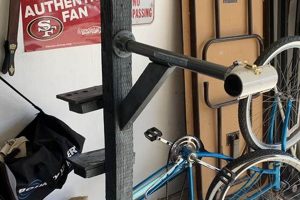A self-constructed support structure designed to hold a forging tool represents an accessible project for metalworkers. These homemade platforms are often built from materials like wood, steel, or a combination thereof, tailored to the specific weight and dimensions of the forging tool. The goal is to create a stable and appropriately-sized base for effective and safe metal shaping.
Constructing a personalized base offers multiple advantages, including cost-effectiveness and customization. Rather than purchasing a pre-made product, individuals can utilize readily available or repurposed materials, significantly reducing expenses. The custom nature of the project allows for a base height that accommodates the user’s physical stature and work preferences, improving ergonomics and minimizing fatigue during extended use. Furthermore, a well-designed support structure enhances the overall forging process by providing a secure and vibration-dampening foundation, leading to improved accuracy and control.
The subsequent sections will delve into specific construction techniques, material considerations, and design variations for building a robust and functional base for a forging tool, providing detailed information for those seeking to undertake such a project.
Construction Tips for a Forging Tool Support
The following guidelines are intended to assist in the construction of a stable and effective base for a forging tool, emphasizing safety and functionality.
Tip 1: Prioritize Stability: The foundation must exhibit exceptional stability. Employ a broad base and consider a three-legged design to minimize wobble on uneven surfaces. A wider footprint enhances overall stability, mitigating the risk of tipping during forging operations.
Tip 2: Dampen Vibrations: Excessive vibration compromises accuracy and increases fatigue. Incorporate sound-deadening materials, such as sand or gravel filling within a steel structure, or utilize resilient wood bases to absorb impact forces. This reduces noise and improves the precision of strikes.
Tip 3: Optimize Height: The height of the forging surface should be ergonomically tailored to the user. A generally accepted guideline places the working surface at knuckle height when standing straight. Precise measurement and adjustment during construction are crucial for comfort and efficiency.
Tip 4: Material Selection: Choose materials appropriate for the anticipated loads. Hardwoods like oak or maple are suitable for lighter duty, while steel is preferable for heavy-duty applications. Ensure materials are free from significant defects that could compromise structural integrity.
Tip 5: Secure Forging Tool Mounting: Employ a robust method for securing the tool to the base. This can involve bolts, chains, or a fitted depression. A secure connection prevents movement during use, enhancing safety and accuracy.
Tip 6: Consider Tool Storage: Integrate storage solutions for hammers, tongs, and other tools into the design. This promotes organization and reduces the risk of tripping hazards within the workspace. Welded hooks or integrated shelving are effective solutions.
Tip 7: Implement Safety Features: Consider adding features such as a surrounding lip or edge to contain scale and debris. This helps maintain a clean and safe working environment, minimizing potential slip and fall hazards.
The effective application of these principles will result in a safe, stable, and ergonomically sound support structure, significantly enhancing the forging experience.
The following sections will address common mistakes and troubleshooting techniques to ensure successful construction.
1. Stability
The inherent function of a support structure for a forging tool necessitates uncompromising stability. The act of shaping metal through hammering generates significant force; any instability in the supporting base directly translates to energy loss and reduced precision in the forging process. A base that rocks, wobbles, or shifts absorbs a portion of the hammer’s impact, diminishing the force applied to the workpiece. The connection between stability and the effectiveness of a self-constructed base is, therefore, causative: greater stability yields more efficient and accurate forging.
Consider, for example, a metalworker shaping a complex piece. Each hammer blow must be deliberate and controlled. If the base is unstable, the metalworker must compensate for the movement, expending additional energy and potentially introducing errors. A stable base, conversely, allows the metalworker to focus solely on the task at hand, improving the quality of the final product. The selection of materials, such as heavy steel or a dense hardwood, directly impacts stability, as does the overall design. A wider base and a lower center of gravity contribute significantly to preventing tipping or unwanted movement during use.
In conclusion, stability is not merely a desirable feature but a fundamental requirement for a functional forging tool support. Addressing this requirement through careful material selection, deliberate design, and meticulous construction is essential for maximizing the effectiveness of the forging process and ensuring the safety of the metalworker. Neglecting stability undermines the entire purpose of the structure and transforms a potentially useful tool into a source of frustration and potential danger.
2. Material Selection
Material selection is a critical determinant in the performance and longevity of a self-constructed support for a forging tool. The choice of materials directly influences the structure’s stability, vibration-dampening capabilities, and overall durability. Consequently, careful consideration must be given to the specific requirements of the intended application before commencing construction.
- Steel: Strength and Rigidity
Steel represents a frequent selection for heavy-duty applications due to its high strength and rigidity. Steel stands are particularly suitable for supporting larger, heavier anvils and enduring the sustained impact forces of forging. Various steel types, such as structural steel (e.g., A36), offer differing levels of weldability and yield strength. The chosen steel’s thickness and grade should correspond to the anvil’s weight and the anticipated forging intensity. Inadequate steel selection can lead to structural failure, posing a safety risk.
- Hardwood: Vibration Absorption and Cost-Effectiveness
Hardwoods, such as oak, maple, or ash, present an alternative material choice, particularly for lighter-duty applications or for individuals seeking to dampen vibrations. Hardwood possesses inherent vibration-absorbing properties, reducing noise and minimizing fatigue during extended use. While generally less expensive than steel, hardwood stands require proper construction techniques to ensure stability. The wood must be adequately seasoned to prevent warping or cracking, and joinery should be robust to withstand repeated impacts. Improperly constructed hardwood stands can be prone to failure under heavy loads.
- Composite Structures: Combining Materials for Optimized Performance
Hybrid designs, integrating steel and wood, offer a means of leveraging the benefits of both materials. For instance, a steel frame can provide structural support, while a wooden top surface can contribute to vibration damping. These composite structures require careful planning to ensure compatibility between the chosen materials. Joining techniques, such as bolting or welding, must be appropriately implemented to maintain structural integrity. The use of dissimilar metals can also introduce galvanic corrosion concerns, necessitating protective coatings or insulation.
- Filler Materials: Enhancing Vibration Damping and Stability
Certain materials, such as sand or gravel, can be used as filler within hollow steel structures to enhance stability and dampen vibrations. Adding dense filler increases the overall mass of the support, resisting movement during forging. The filler material should be dry and inert to prevent corrosion or degradation of the steel. Furthermore, the structure must be sealed to prevent leakage of the filler material. Incorrectly applied filler can add unnecessary weight without significantly improving stability or vibration damping.
The ultimate material selection for a self-constructed support is contingent upon several factors, including the anvil’s size and weight, the intended forging intensity, budget constraints, and the builder’s skill level. Regardless of the chosen material(s), rigorous attention to detail during construction is essential for creating a safe, stable, and durable structure. Failure to adequately consider material properties and construction techniques can compromise the integrity of the stand, potentially leading to accidents or equipment damage.
3. Height Adjustment
Height adjustment is a critical ergonomic consideration in the design and construction of a self-made forging tool base. Proper height optimizes the user’s posture and reduces strain during forging operations, directly impacting efficiency and minimizing long-term physical stress.
- Ergonomic Optimization
The primary goal of height adjustment is to position the forging surface at an optimal level relative to the user’s body. Generally, the ideal height places the work surface at or slightly below the user’s wrist when standing upright. This alignment minimizes the need for excessive bending or reaching, reducing strain on the back, shoulders, and wrists. Failure to optimize height can lead to chronic pain and reduced productivity.
- Customization and User Variability
Human height varies significantly; therefore, a one-size-fits-all approach to stand height is inadequate. The ability to adjust the height allows for customization to accommodate individual physical characteristics. Furthermore, adjustability enables multiple users to comfortably utilize the same forging station. This flexibility is particularly valuable in shared workshop environments or educational settings.
- Methods of Height Adjustment
Several methods exist for implementing height adjustment in self-constructed bases. These include telescoping legs with locking mechanisms, adjustable feet or leveling pads, and shim-based systems. Telescoping legs offer the most versatile adjustment range, while adjustable feet provide a simpler solution for minor height corrections. Shim-based systems are a cost-effective option but require more manual effort for adjustments.
- Stability Considerations
The incorporation of height adjustment mechanisms must not compromise the overall stability of the base. Adjustable legs should be robustly constructed and securely locked to prevent wobbling or collapse under load. Adjustable feet must be sufficiently wide to distribute weight evenly. The design should prioritize safety and prevent unintentional adjustments during forging operations.
The inclusion of height adjustment in a self-constructed forging tool support represents a significant investment in user comfort and long-term physical well-being. By carefully considering ergonomic principles and implementing a robust adjustment mechanism, the builder can create a workstation that promotes efficient and safe forging practices.
4. Vibration Damping
Vibration damping is a crucial consideration in the design and construction of a self-made support for a forging tool. The hammering process inherently generates significant vibrations, which, if unchecked, propagate through the structure and into the surrounding environment. These vibrations not only contribute to noise pollution but also negatively impact forging accuracy and can lead to user fatigue. Therefore, effective vibration damping is essential for creating a functional and comfortable forging station.
The relationship between vibration damping and the support is direct: a properly damped stand minimizes energy loss due to vibration, thereby maximizing the force applied to the workpiece. Conversely, an undamped stand will dissipate energy as vibration, making each hammer blow less effective and potentially causing the workpiece to move or deform unpredictably. Various techniques can be employed to achieve effective vibration damping, including the use of dense materials, such as steel or hardwood; the incorporation of sound-deadening materials, such as sand or rubber; and the implementation of specific structural designs that minimize vibration transmission. For example, a steel stand filled with sand exhibits significantly reduced vibration compared to a hollow steel stand of similar dimensions. Similarly, a wooden stand constructed from dense hardwood offers greater damping capacity than one built from softwood.
Successful vibration damping requires a holistic approach that considers material selection, structural design, and the incorporation of specialized damping elements. While achieving complete vibration elimination is often impractical, significant reductions can be achieved through careful planning and execution. The benefits of effective vibration damping extend beyond noise reduction and improved forging accuracy; they also contribute to a more comfortable and productive working environment, reducing user fatigue and promoting long-term physical well-being. Neglecting vibration damping in the design and construction of a self-made stand can result in a less effective, less comfortable, and potentially unsafe forging experience.
5. Secure Mounting
Secure mounting represents a fundamental aspect of any functional support structure for a forging tool. The connection between a robust fixing method and the utility of the crafted base is direct and causative: Without a means to reliably affix the forging tool to the base, the assembly is rendered largely ineffective and potentially hazardous. The forces generated during forging necessitate a connection capable of withstanding repeated high-impact loads and preventing movement of the tool relative to the support. Failure to adequately secure the tool leads to diminished forging accuracy, increased user fatigue, and an elevated risk of accidents due to slippage or instability.
Various techniques exist for achieving secure mounting, each with distinct advantages and limitations. Options include bolting the tool directly to the base, utilizing chains or straps to restrain movement, creating a form-fitting recess within the stand to cradle the tool, or employing a combination of these methods. The selection of an appropriate method depends on the tool’s shape, weight, and the materials used in constructing the base. For instance, a forging tool with pre-existing mounting holes may be securely bolted to a steel base, whereas a tool lacking such features might require a custom-fitted wooden cradle and supplementary chain restraints. Practical application necessitates careful consideration of load-bearing capacity, material compatibility, and ease of maintenance.
In summary, secure mounting is an indispensable element in the successful construction of a functional support structure. The reliability of the fixing method directly impacts forging accuracy, user safety, and the overall longevity of the assembly. Prioritizing secure mounting through meticulous design and implementation ensures the crafted support fulfills its intended purpose and provides a safe and efficient platform for metalworking endeavors.
6. Tool Accessibility
Effective tool accessibility constitutes a crucial component of a functional self-constructed forging tool base. The spatial organization of associated implementshammers, tongs, punches, and measuring devicesdirectly influences workflow efficiency and safety within the forging environment. A poorly organized workstation necessitates frequent interruptions to retrieve tools, thereby reducing productivity and increasing the potential for accidents. Conversely, a well-planned base incorporates integrated storage solutions that facilitate quick and convenient access to necessary implements.
The integration of tool storage into the support structure takes various forms. For instance, strategically placed hooks or pegs along the perimeter of the base provide readily accessible hanging points for hammers and tongs. Small shelves or trays mounted beneath the forging surface offer convenient storage for punches, chisels, and measuring tools. Some designs incorporate drawers or cabinets for secure storage of more delicate or specialized equipment. Consider a blacksmith utilizing a hand-forged hold-down. Time spent searching for it among scattered tools detracts from productive labor and increases the risk of misplacing the hold-down, resulting in wasted effort. A designated hook or shelf ensures the hold-down remains readily available, minimizing disruptions and promoting a more streamlined workflow. The absence of well-placed storage risks creating a cluttered workspace, presenting tripping hazards and increasing the likelihood of tool damage.
Therefore, optimizing tool accessibility within the construction of a forging tool base warrants careful planning and execution. The objective involves creating a system that minimizes wasted motion, reduces clutter, and promotes a safe and efficient working environment. Thoughtful integration of storage solutions transforms the base into a more comprehensive and functional component of the forging process. Neglecting accessibility considerations diminishes the overall utility of the base and compromises the blacksmiths productivity and safety.
7. Safety Features
The integration of safety features into a self-constructed forging tool support represents a crucial aspect of responsible design and construction. The forces involved in forging inherently present risks of injury, necessitating proactive measures to mitigate potential hazards. Safety features, therefore, are not mere optional additions but integral components that directly impact user well-being. The absence of such features elevates the risk of accidents resulting from flying debris, instability, or improper tool handling.
The practical application of safety considerations takes numerous forms. A containment lip or edge surrounding the forging surface effectively prevents hot scale and metal fragments from scattering across the work area, reducing the risk of burns or slips. Non-slip surfaces on footings or a wide, stable base minimizes the likelihood of the entire stand tipping over during forceful hammering. Careful attention to welding quality, material strength, and secure tool mounting prevents structural failure, mitigating the risk of the forging tool becoming dislodged. Consider the construction of a stand from repurposed materials; a thorough inspection for pre-existing cracks or weaknesses is essential to prevent catastrophic failure under load. Properly positioned and well-lit work areas reduce visual strain and improve accuracy, lowering the chance of misdirected hammer blows. These examples underscore the cause-and-effect relationship between the inclusion of safety features and the reduction of workplace accidents.
In conclusion, the incorporation of safety features into a forging tool support is not simply a matter of compliance but a fundamental responsibility. While self-construction offers the advantage of customization, it also demands a heightened awareness of potential hazards and a commitment to implementing preventative measures. Challenges may include a lack of formal engineering expertise or limited access to specialized safety equipment. Despite these hurdles, the long-term benefits of a safe and well-designed support far outweigh the initial investment of time and resources, ensuring a secure and productive forging environment.
Frequently Asked Questions
The following section addresses common inquiries regarding the construction of a support structure for a forging tool, emphasizing critical considerations for safety, stability, and functionality.
Question 1: What is the most critical aspect to consider when constructing a support?
Stability is paramount. The structure must withstand significant impact forces without wobbling, shifting, or tipping. A wide base, robust materials, and secure joinery are essential for achieving adequate stability.
Question 2: Is steel always the best material for a support?
While steel offers superior strength for heavy anvils, hardwoods can provide adequate support for lighter tools and offer vibration-dampening benefits. Material selection depends on the anvil’s weight and the intended forging intensity.
Question 3: How important is height adjustment?
Height adjustment is crucial for ergonomic optimization, minimizing strain and fatigue during forging operations. The ideal height places the work surface at or slightly below the user’s wrist when standing.
Question 4: What is the best way to dampen vibrations?
Vibration damping can be achieved through material selection, structural design, and the incorporation of damping elements. Filling hollow steel structures with sand or using hardwood for the base are effective techniques.
Question 5: How should the forging tool be secured to the support?
Secure mounting is essential for preventing movement during forging. Bolting, chaining, or creating a fitted recess are common methods. The chosen method should withstand repeated high-impact loads.
Question 6: Are there any essential safety features to include?
Yes. A containment lip or edge prevents hot scale from scattering, and non-slip surfaces on footings enhance stability. Thorough inspection of materials and robust construction techniques are also critical.
Effective construction hinges upon the integration of stability, appropriate materials, ergonomic design, vibration damping, secure mounting, and comprehensive safety features. Prioritizing these elements results in a safe and efficient forging workstation.
The subsequent section will delve into common errors encountered during the construction process and offer troubleshooting advice to ensure a successful outcome.
DIY Anvil Stand
This exploration of the self-constructed forging tool support has addressed critical facets, encompassing stability, material selection, ergonomic considerations, vibration mitigation, secure tool mounting, accessibility, and safety protocols. Each of these elements contributes to the creation of a functional and reliable workstation for metalworking. Omission or inadequate implementation of any single component can compromise the stand’s overall utility and introduce potential hazards.
The construction of a robust platform demands rigorous adherence to established principles of structural integrity and ergonomic design. Individuals undertaking such projects should prioritize safety and accuracy throughout the process. A well-executed effort yields a tool that enhances the efficiency and precision of metalworking tasks. Conversely, a poorly designed or constructed stand can detract from the forging experience and increase the risk of injury. Further research and careful planning are essential for those seeking to embark on the construction of a durable and effective base.







